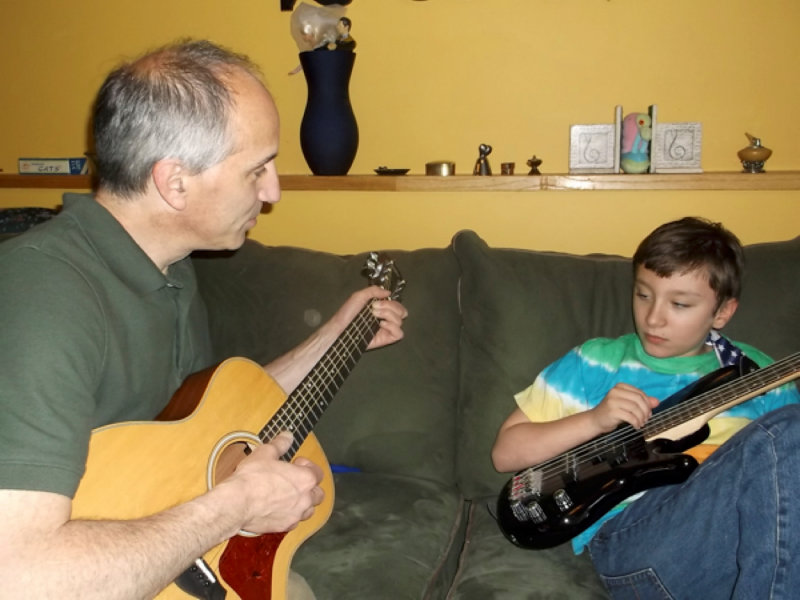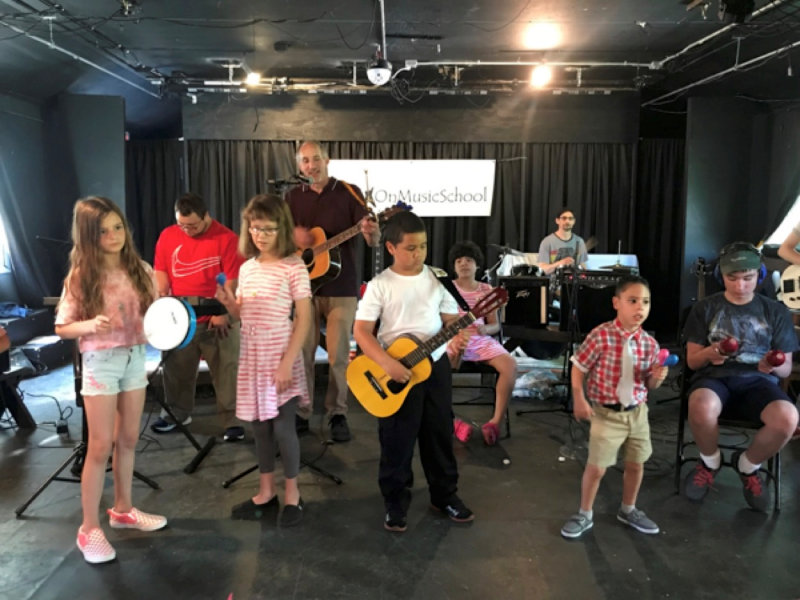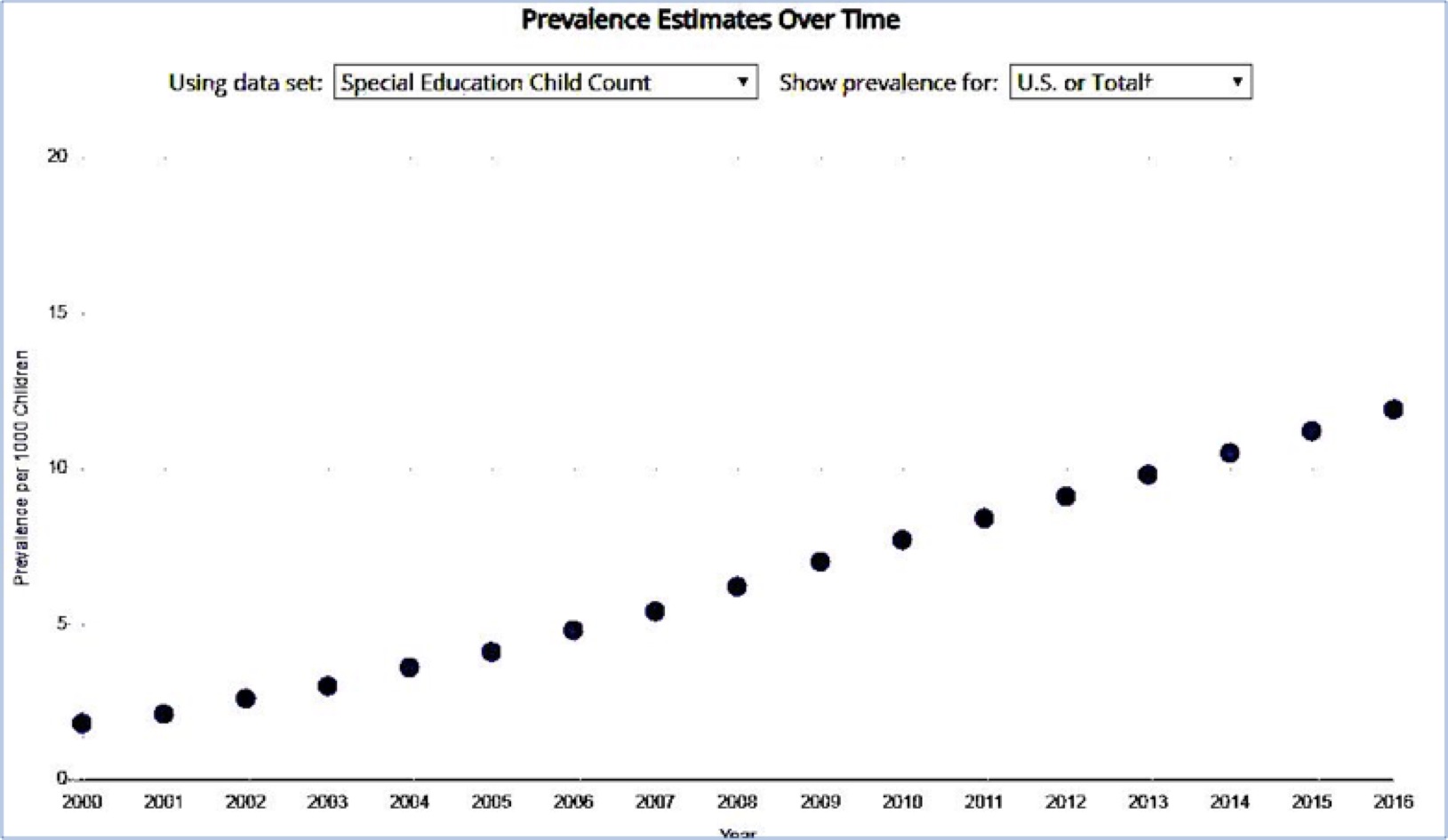 David plays with a student who is learning bass guitar.
David plays with a student who is learning bass guitar.
In Demand
Music Specialist for Children With Special Needs
by David Meyers
It’s nine o’clock Friday morning. The creaking sound of wheels on my handcart is echoing off the elementary school’s concrete block walls. Children walking by are staring at the load of instruments I am pulling. They smile and say, “Hello Mr. Dave.” I smile back. Inside I am pinching myself, thinking, How did I get here?
For thirty years in my professional life, I had been a small business owner, working on construction sites or conducting property inspections. My music was a hobby, perhaps a day each month set aside to jam with friends. From time to time, I would teach guitar in the evening, though was never able to turn teaching into a consistent business model. But now I work as a music specialist five days a week, and I do not plan to go back.
How I Got Started
It’s funny how life can throw you curve balls and point you in a direction you were not expecting. The myriad of unsatisfying accomplishments and economic failures kept pushing me to find new professional endeavors. While between jobs in 2008, I presented a guitar-learning program for various age groups at a local recreation department. My initial plan was to teach easy classic pop songs, for example, Credence Clearwater Revival’s “Proud Mary” (aka “Rollin’ on the River”). Everyone knows that song, right? Wrong! Most had not heard the songs I suggested. I soon realized I could not expect today’s youth to be motivated by songs I grew up with. The next thought was to adjust the current pop songs to an easy play form. Wrong again! I was not able to find a song with acceptable, non-sex-related themes. Besides, the songs are quickly forgotten as new pop emerges.
 David and his students perform at the 2019 RockOn concert.
David and his students perform at the 2019 RockOn concert.
Therefore, I needed to create my own songs that were motivational and easy to play. Each year they would be fresh for new students. So, I began creating what eventually became my curriculum of “Accessible Music.”
The recreation program ran for several years but eventually interest waned, and it was discontinued. Then, a casual conversation during a party in 2016 would change my life. A friend was discussing the difficulties in finding recreation activities for their son, a ten-year-old child with autism. It was decided that I would try to teach him to play music.
Not long after, I began to see the positive impacts. He seemed more outgoing, socially connected, and creative. If my special way of teaching could benefit this one child, perhaps there was a wider application. So in 2017, I decided to reach out to other parents, teachers, and organizations who are providers for the special needs community to see if I could attract more students. Now I service more than fifty children each week through one-on-one and group music programs.
Growth Area
Anyone who works in public education knows the number of children in special education programs has skyrocketed. Data from the Centers for Disease Control and Prevention (CDC) show an alarming trend. Their survey in 2014 showed the Identified Prevalence of Autism estimate was 1 in every 59 children, a 250 percent rise since 2000. The CDC also published data from the U.S. Department of Education, shown in the graph here. It reveals a six-fold increase in the prevalence of children receiving special education from 2000 to 2016. Wow! Locally, I found the availability for skills building and recreation activities that can accommodate special needs falls below the growing demand.
 Source: Centers for Disease Control and Prevention
Source: Centers for Disease Control and Prevention
A guardian of someone with a disability may be eligible for benefits paid through Medicaid. In my state (New York), this is administered through its Office for People With Developmental Disabilities (OPWDD). Approximately seven years ago, OPWDD began its Self-Direction program, which allows guardians to have more control over the activities and caregivers that work best for their children. The benefits of music for fine motor skill and language development are widely documented. Music is a recreational activity that can serve a client’s long-term goals. If your music program is approved by a client’s fiscal intermediary, its cost will be paid from their Medicaid budget. According to the NY State OPWDD, my region (Hudson Valley and Capital District) has seen a three-fold increase in Self-Direction enrollment in just over two years. At least forty states offer some form of Self-Direction service, so this is probably expanding in your area also. Much of my recent growth can be directly attributed to networking with parents, brokers, and administrators involved in the Self-Direction Program.
In early 2017, I took on another student on the autism spectrum, a high-functioning teenager whose family I was acquainted with. I invited them to my home studio. After taking a minute to chat with his mother, I discovered that the student had taken my guitars and precariously balanced them against a round, spinning stool. I lifted one guitar, then the stool became unbalanced and the instruments tumbled. A lesson learned. My cluttered studio was perhaps not the best environment for those with sensory overload. It was decided I would take my lessons on the road to the homes of the clients. This is a great benefit to the caregivers, as transporting children with anxiety or physical limitations can be a struggle.
Developing a Marketing Plan
Previously I had no experience or formal education in special education. Though my wife, Robin, works in this field, we did not experience special needs with our own children. However, it did not take me long to make connections. Many parents and guardians of children have already formed networking groups to share struggles and need for services, and to learn best programs and practices. There are many online forums, school functions, and nonprofit organizations created to share resources. Here is list of avenues I found to connect with potential clients and develop a market presence:
- Social networks, resource lists
- Special Education Parent Teacher Organizations (SEPTOs), Special Education Parent Teacher Associations (SEPTAs)
- Recreation programs
- Benefit brokers and institutions
- Local publications
Searching keywords on Facebook, I found several groups created for parents to share stories and resources. These groups may not be open to the public, but if you explain to the administrator how you can benefit the community, they may allow you to post on their pages. There are online resource guides published by municipal departments or local and national nonprofits. Many local school districts have separate parent-teacher organizations for special education students—a good place to make connections or even a presentation about what you do. I was also able to tap in to local organizations already providing group recreation for children with disabilities. These programs may run for six to twelve weeks at a time but are a great supplement to my private sessions.
New York OPWDD publishes a list of benefit brokers and administrators. They may be interested in finding suitable activities for their clients. Local publications and online neighborhood forums are always looking for feel-good community content. Write a press release on how you benefit the special needs community, and they may publish a story about you.
How to Connect to Your Students
My guerilla marketing skills from my years as a small business owner were helpful. But what is the key to my success and sustainability and keeping clients? It’s in the music. My tools are my songs (and sometimes your songs) that are specifically arranged to be motivational and accessible to my students. If I can build their confidence and attention, they can start on a path to a lifetime of musical participation.
Autism on its face is a social disorder, so it may take a while for the students to connect to you and your music.
Here are some basic suggestions for lesson planning:
- Use lots of short activities to start.
- Keep students physically connected to an instrument.
- Structure songs to include responsive breaks.
- Choose songs that are physically and verbally accessible.
- Find out what motivates students and incorporate it into music.
“Be My Friend”
Music intertwines melody and rhythm, cadence and meaning, structure and improvisation, expression and controlled emotion. This is a lot for a sensory-challenged individual to filter and respond to in the appropriate way. Children with autism may need outside motivation to begin the journey into musical participation, whether it’s through the use of humor, their pet, family, favorite food, or superhero, I suggest incorporating what they already love into the music so they can develop their own reasons for reacting.
Some of these concepts are found in my song “Be My Friend.” It is based on open strings on the guitar for physical accessibility. The song structure has a repeating pattern with responsive breaks to go “Boom” or “Yeah.” Lyrics include things such as pizza and Xbox games, which kids almost universally enjoy.
The Scoop
Here’s how I’d sum up my work as an independent music specialist:
BENEFITS
Fulfillment
Consistent interest
Using others’ facilities
Paid from benefit sources
Limited competition
|
PITFALLS
Difficult scheduling
Diverse lesson planning
Using others’ facilities
Requires equipment maintenance
Physically taxing
|
In a little over two years, I have been able to set up a five-day-a-week schedule and declare that music is my full-time job! However, this came at the price of consistent effort. It didn’t take me long to realize that my private lessons with children are limited to after school hours. To expand my workday, these are supplemented with group sessions sponsored by nonprofit recreation organizations. My marketing also attracted young adults who are home during school hours. My clients are of all ages and reflect a wide range of functionality. This diversity requires significant organization and lesson planning to suit the individual tastes and skill levels.
The feeling of fulfillment in bringing skills and confidence to a disabled individual is awesome. Because many have limited access to other recreation, my lessons are a highlight of their week. I do not have the liability of maintaining or renting my own facility. Many clients are reimbursed and do not pay out-of-pocket, so they would like me to come often. And I have not found any local competitors who perform this unique in-home service.
However, the job is not without difficulties—most notably, scheduling. As my immediate location is semi-rural, I travel throughout the northern New York suburban area from five to forty miles from my home. Putting together a workable schedule around the client’s family lifestyle and activities is a challenge. Cancellations due to illness, doctor appointments, and weather emergencies are fairly common. I estimate 10 to 15 percent of my scheduled lessons are cancelled in a typical week.
The benefit of using another’s home or facilities may be offset by sibling rivalries, pets, and life’s messes that can interrupt the lesson flow. The instruments I provide may be accidentally abused, licked, smelled, scratched, bent, dropped, or used in ways you didn’t know existed. Cleaning and fixing my instruments is now part of my weekly, if not daily, routine. In my old job, it was easy to “tough out” minor illnesses at work. Now I am more likely to stay away if I have a cold, as I work in such close contact with my clients. Also, I was not expecting that my new weekly routine would be so physically taxing. By the weekend, sore arms, shoulders, and throat are in need of rest.
What Does the Future Hold?
It was New Year’s Day, 2017, when I made a commitment to pursue a career applying my music skills to benefit the special needs community. I am proud to say that in two years I was able to make this idea into a viable reality. However, I am still not sure what is the next step. Perhaps the knowledge base of CMNers can help.
Though I would like to do this all day and night, my body and voice can only perform so many classes each week. Though this supplies me with a moderate income, I want to continue to grow my cash flow as well as meet the growing demand. Could I expand and train others in my methods? Should I become a not-for-profit and pursue donations and grants for this worthy cause? Can I make money publishing my songs and articles about this topic? These thoughts are running through my head as I drive to my next lesson. I would love to hear yours, so please share them with me: dmeyers12531@gmail.com.
Want to hear some of the music David uses to capture attention and motivate children with autism? Attend his song swap at at the 2019 CMN Conference in Arizona. Hope to see you there!